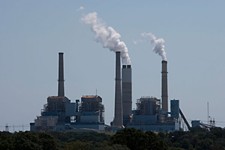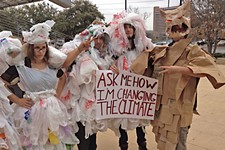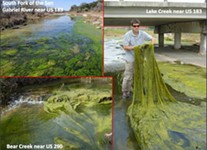Keeping Busy
Former regional EPA head Al Armendariz has a full agenda at the Sierra Club
By Nora Ankrum, Fri., Sept. 14, 2012
(Page 2 of 4)
AC: Other important cases are happening as well. One is regarding the Cross-State Air Pollution Rule. Can you give me a sense of the importance of that case and its implications for Texas? [Texas was among the plaintiffs contesting this rule; a decision was pending at the time of this interview. On Aug. 21, the DC Circuit Court of Appeals ruled against EPA [pdf of ruling attached to email]. The decision, a two-to-one ruling, was made by a different panel of judges than those who ruled unanimously in favor of EPA in Coalition for Responsible Regulation v. EPA.]
AA: Sure. The Cross-State Rule is critical because it reduces emissions of two of the most dangerous air pollutants: sulfur dioxide and nitrogen dioxide. And it's targeted at facilities that have such large emissions that they affect communities in downwind states. EPA determined that a number of large sources in Texas – and, in particular, a large number of coal-fired power plants owned by Luminant, as well as a few other operators – had emissions large enough to affect communities in downwind states.
AC: Our downwind states are those east of Texas?
AA: Yes, these are states to the east and northeast of Texas. So when this rule is implemented, it's going to require the power plants in the state to reduce their emissions, and the nice collateral benefit is that Texas communities will also enjoy the health benefits. So the rule is going to target emissions from sources because of their impact on downwind states, but the collateral benefit is that Texans who live near these plants will also experience the public health benefits when those emissions are reduced.
AC: So if there's not a favorable ruling for the EPA, what will the next step be?
AA: Well, with the Cross-State Rule, or most other EPA regulations, if a decision goes against the agency, what the agency is often instructed to do by the courts is to modify the regulation to comply with instructions by the court. It's very rare that a court will structure a rule itself. What typically happens is a court will either uphold a rule that is promulgated by an executive agency or, if it identifies flaws, it instructs the federal agency to go back, to correct the rule, and to republish it. And I'm optimistic that the Cross-State Rule is going to be upheld – but even if it's not, I would anticipate the ruling of the court in that case to instruct EPA to go back and fix some flaws in the rule and to then republish it. [Ed.'s note: The court has vacated the CSAPR, which means EPA will have to make modifications before moving forward with regulation on this issue; Armendariz suspects EPA might appeal the court's decision. CSAPR was itself a modification based on a previous D.C. Circuit Court ruling that EPA's rules regarding downwind pollution were too weak.]
And that's how the Cross-State Rule came about, during the Bush administration. The Bush administration put forward a rule that purported to reduce emissions from one state to another, and they called it the CAIR Rule. That stood for the Clean Air Interstate Rule . But the environmental community sued because they felt that the rule was not strict enough and didn't comply with the requirements of the Clean Air Act, and they won. So what the federal courts did is they sent the CAIR Rule back to EPA. They said the rule's not stringent enough, and you need to correct a number of provisions, so the agency published the Cross-State Rule as the outgrowth of the decision on the Clean Air Interstate Rule. So again, this is just an example of how the courts rarely themselves will restructure rules or write rules when it comes to environmental regulations. What's more common is either they uphold the rules as they're written and the agencies win, or they instruct the federal agencies to go back and correct flaws and republish the rule. And so the decision from the Cross-State Rule is likely to be one of those two options.
AC: Is that similar, then, to where EPA stands right now with the ruling on Texas' flex permitting?
AA: Sure, it's exactly the same. TCEQ [Texas Commission on Environmental Quality] has been trying to get approval for a flexible permitting program for about 15 years, and the agency decided when I was there that the program as it was written by TCEQ could not be approved – and therefore should not be implemented. The court ... decided that EPA's rationale for not approving the flexible permitting program was flawed, so they sent the flexible permitting request back to EPA, so EPA is going to have another opportunity to rule on whether the program should be approved or not.
The flexible permitting program is severely flawed. What the agency did is it decided on a legal strategy to disapprove it based on a certain reading of the Clean Air Act. The court decided that that rationale is insufficient. So now EPA is likely to go back and move forward with the disapproval, [but] with a different set of reasons and a more robust record, and republish the disapproval after it has that record.
AC: It seemed like there were two different arguments in the ruling, one being what you just mentioned, and the other being this idea that EPA's action is "16 years tardy," as the judge [E. Grady Jolly] wrote.
AA: The Clean Air Act does instruct EPA to evaluate requests from states – to add permitting programs like a flexible permitting program or to change existing programs – as quickly as possible and within a year. Unfortunately, EPA – long before I or [EPA] Administrator [Lisa] Jackson came into office – had been sitting on this request by the state of Texas to add a flexible permitting program to the state Clean Air Act program.
It's important to realize that the state of Texas does have maybe what we'll call a standard permitting program, and they implement that program in a way very similar to the other 49 states. So the other 49 states have an air permitting program that's implemented generally the same way that Texas implements its standard permitting program. But what Texas wanted to do was add another piece to its standard permitting program; they wanted to add an alternative to its standard permitting program called the flexible permitting program, and they asked EPA in the mid-Nineties for permission to do so.
The Clean Air Act is very clear. Judges have repeatedly upheld that until EPA says yes, you shouldn't implement them [revisions]. It's kind of like asking ... It's the kind of thing where EPA is given authority under the Clean Air Act to decide if an alternative program or change to an existing air program is consistent with the Clean Air Act, and unless and until EPA says yes, the answer is no. So EPA has never approved the flexible permitting program, Texas has never had an approved flexible permitting program, and the court ruling ... doesn't change that fact. They've never had a flexible permitting program. They didn't a year ago, they didn't 10 years ago, and they don't today.
What the court did is told EPA that the rationale that it used to say no – the rationale that it used to disapprove the state getting a flexible permitting structure – was insufficient, and if it wanted to say no it had to come up with a more robust rationale, it had to come up with a different legal argument. So I suspect that's what the agency's going to do over the near term.
AC: My understanding is that part of the problem with the flexible permit program is that it allows a plant's emissions standards to be based on the entire plant rather than per unit. Why is that bad?
AA: Well, you can imagine if you and your significant other, rather than both of you being held to the speed limit on the highway [in which] each of you had to stay below 70 miles per hour, rather than that, imagine if you had a bubble limit, and the bubble limit for your family was 140 miles per hour. It would be impossible for the police who are monitoring traffic out on [Interstate Highway] 35 to know whether or not you, as you're traveling 80, are doing so legally, because simultaneously at that exact same time, your spouse would have to be traveling less than 60. Or if you're traveling 100, then you could only do so if your spouse on 35 at that time is traveling less than 40.
The enforceability becomes extremely difficult if you have a bubble limit that goes across multiple units, because you simultaneously have to know what each emission point is emitting in order to be able to compare the cumulative emissions of all those sources to your bubble limit. And so it's what we call "practical enforceability." By applying a bubble limit across an entire facility – especially a large, complex facility that has multiple boilers and multiple process units and other large sources, as well as numerous medium-sized and smaller sources, versus when you put all of that under a bubble limit – the limit under the flexible permit becomes practically unenforceable. There's no way for an inspector or someone from EPA or TCEQ or the Department of Justice to go to the facility and to know whether that facility is in compliance, because there's no way to measure simultaneously what the emissions are across the entire facility all at once.
AC: Really? It's hard to understand why one couldn't figure out how much the plant is emitting all at once.
AA: It's partly because some of these units at the facility might have monitors on them that record emissions 24/7, to tell you what's going into the air. Some of them don't, and they're simply estimated, based on an engineer's calculations. Others have their emissions based on daily through-put values, the crude oil through-put for that day or the amount of coal burned that day. And so what you end up having are a number of sources across a facility that have emissions estimated very different ways.
Got something to say on the subject? Send a letter to the editor.













